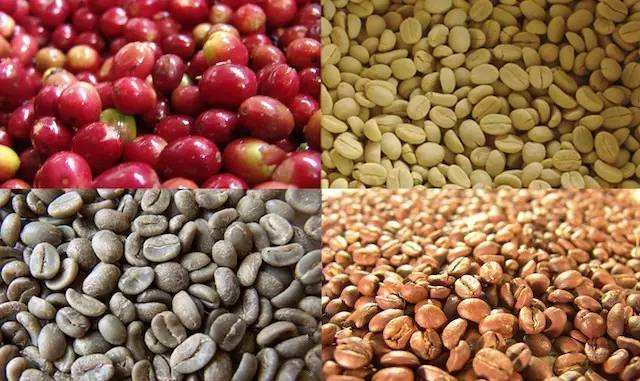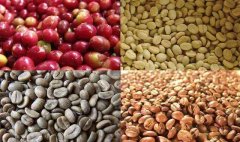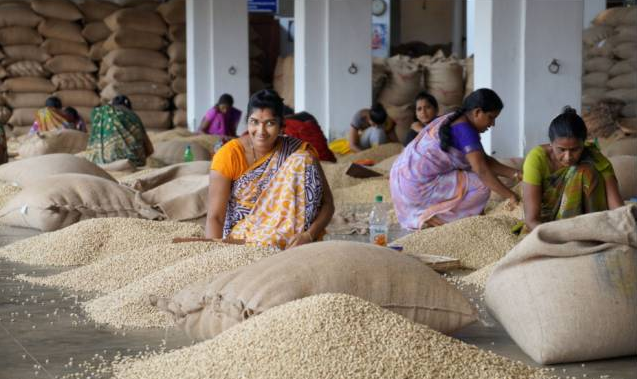Coffee bean semi-washing & honey treatment & pulp solarization method
Follow the caf é (Wechat official account vdailycom) and found that Beautiful Cafe opened a small shop of its own.
When coffee farmers pick them, they look like this, not the coffee beans we see now that are processed and roasted. All we need is coffee seeds, so the treatment can remove the skin and flesh and leave the seeds.
one
Semi-washing treatment
Semi-washing treatment (Semi washed) can be said to be the combination of sun-drying and water-washing. The idea is to use less water than water washing to produce coffee with a cleaner flavor and a thicker taste than the sun washing method, which is popular in Indonesia, Mantenin and other places, and semi-washing has been used in Brazil in recent years.
Step 1: filter
As with other treatments, coffee cherries need to be screened first. If you put the picked coffee cherries in the pool, the ripe fruit will precipitate to the bottom of the pool, while the unripe fruit will float on the surface. Coffee farmers need to screen out the immature fruit first.
Step 2: remove the peel and pulp
The procedure is the same as the washing method, using a special machine to remove the peel and pulp, leaving only the coffee beans wrapped in the endocarp, but at this time, there is still a small layer of colloid on it.

Step 3: remove pectin
Use a pectin scraping machine (Demucilager) to remove the attached pectin, which uses only a small amount of water compared to the washing method.
Step 4: air drying
Take out the coffee beans with a smooth surface and dry them outdoors until the water content is reduced to 12%.
Flavor characteristics
Semi-washed coffee not only has the thick flavor and sweetness of sun beans, but also has the clean, soft but not insipid taste of washed beans.
two
Honey treatment & flesh solarization method
Why do we put "honey treatment" and "pulp solarization" together here? In fact, in the steps, the honey treatment is the same as the flesh solarization method. In Brazil, this treatment is called pulp solarization (pulped natural), while in Central America, such as Costa Rica, it is called honey treatment (honey process).
Step 1: filter
As with other treatments, immature coffee fruits are selected after soaking in the pool.
Step 2: remove the peel and pulp
In this step, the pulp sun drying method is roughly the same as honey treatment, the coffee fruit is poured into the peeling machine to remove the skin and pulp, but the difference is:
Honey treatment: honey treatment can determine how much flesh is removed, that is, yellow honey (coffee with more than 50% scraped flesh), red honey (coffee with scraped less than 20% pulp), and black honey (coffee with almost no scraping flesh).
Flesh solarization: Brazilian peeling machines generally do not have the function of adjusting the peeling caliber, scraping off most of the pulp by default, that is, the "yellow honey" grade.
Step 3: bask
Honey treatment:
Yellow honey: scraped off more than 50% of the pulp of coffee, the drying method needs to be the most direct heat absorption, accept the most light drying, lasting for about 8 days, the final water content reached about 12%.
Red honey: coffee that scrapes off less than 20% of the pulp, dries longer than yellow honey, and reduces direct sunlight exposure for about 12 days.
Black honey: coffee with almost no scraping flesh can be used for the longest time, ranging from 2 weeks to 4 weeks, to avoid too strong sunlight, prevent drying too fast, and make sugar conversion more fully.
Flesh insolation:
The same is the sun, but due to the removal of the pulp, the drying time will be shorter than the sun method, about 10 days.
Step 4: shelling
The dried coffee beans with a moisture content of about 12% are fed into a sheller to scrape off the seed shell and the remaining fermented pulp to produce raw beans.
Flavor characteristics
The flavor of pulp tanning and honey treatment is very similar to that of sun-cured coffee, which has a thick taste, low acidity and high sweetness.
Important Notice :
前街咖啡 FrontStreet Coffee has moved to new addredd:
FrontStreet Coffee Address: 315,Donghua East Road,GuangZhou
Tel:020 38364473
- Prev

Why does coffee need to be processed? Introduction to the difference in the process of washing coffee beans and drying honey
Before understanding the treatment, there is a knowledge that must be popularized to non-coffee enthusiasts: what is coffee? 1 Coffee is a shrub or small tree of Rubiaceae. The first flowering time is about three years old, and the white flowers will give off a faint fragrance of jasmine and begin to bear fruit a few months later.
- Next

Indian coffee bean season wind soaking method
The monsoon coffee we are talking about today comes from India, a magical country, and even the coffee is a bit legendary. Legend has it that a pilgrim named Baba Budan smuggled seven coffee beans through Yemen on his way back from Mecca. In order to avoid Arab inspection, he wrapped seven coffee seeds in cloth, hid them in the cracks in his ribs, and brought them to his own India.
Related
- What is the meaning of lactic acid fermentation with coffee bean treatment?
- How to judge the state of foam by sound?
- How does the latte pull out the unicorn pattern? Come to get for a little trick to improve the flower pull!
- Will flower pulling affect the taste of the latte?
- Do you know the history of coffee?
- The difference between honey treatment and sun washing what is raisin honey treatment?
- What kind of milk can a novice use to make coffee foam to keep the foam longer? The correct method and skills of milking tutorial sharing
- Why do washed coffee beans taste sour? Flavor characteristics of washed Coffee
- Introduction to the skill of how to practice the size and height of water injection around the circle of hand-brewed coffee
- How do beginners practice coffee flower drawing from scratch?

